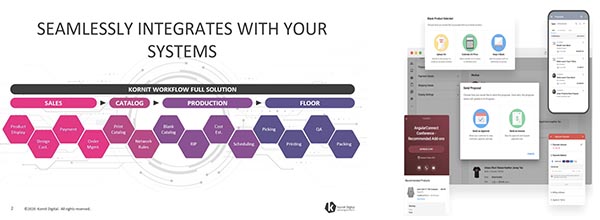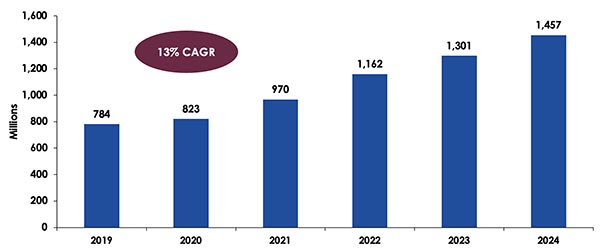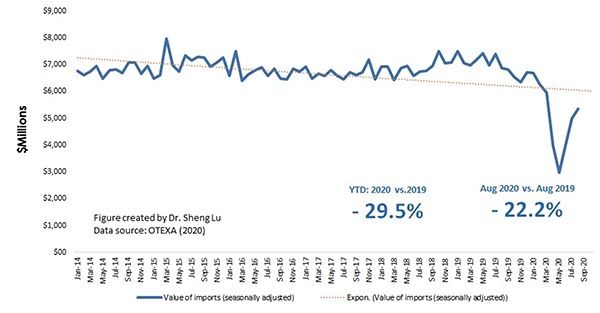- COVID-19 further accelerated brick-and-mortar store closures at a time when closures were already commonplace. Many of these stores will not reopen even after restrictions lift.
- Workflow automation and web-to-print technologies are empowering consumers to easily customize garments like never before, enabling them to become their own designers.
- 2020 direct-to-garment print volumes exceeded those from 2019, fueled by unprecedented increases in ecommerce sales—primarily in North America.
- In a post-pandemic landscape, manufacturers and retailers will rely more heavily on direct-to-garment technologies for product development, trend analysis, and real-time graphics testing.
By Mike Bertini
Introduction
Do you remember what life was like before COVID-19? Sometimes it’s hard to recall what things were like before we had to worry about facemasks, social distancing, or transforming our homes into virtual workspaces. So much has changed in the past 14 months, including how we shop for imprinted activewear and apparel. As lockdowns were imposed and stores were forced to temporarily shut down, many turned to the Internet for the latest fashion and graphics trends. In doing so, they discovered a virtual marketplace where seemingly endless product options rule and personalization takes on a whole new meaning. No longer were they limited to the square footage in a physical storefront; unlimited options were now at their fingertips.
Consumers weren’t the only ones who quickly learned to adapt. Manufacturers and retailers had to reinvent their go-to-market and supply chain strategies as off-shore purchase orders were either cancelled or delayed, leaving them with few new products to sell. Just-in-time (JIT) manufacturing became vital as small runs were able to be produced by local factories utilizing digital printing technologies. Direct-to-garment (DTG) became not only a means of on-demand production, but also a resourceful tool in real-time trend analysis and graphics testing.
As a result, print service providers (PSPs) experienced unexpectedly high order volumes, leading to increased demand for new devices in the second half of 2020—particularly in North America. This was welcome news to OEMs as most ended 2020 with year-over-year gains despite the pandemic.
The Dynamic of Choice
It wasn’t long ago that limited choices dominated the decorated apparel landscape. Brands would forecast future trends in the hopes that they hit the target and end each season with little unsold inventory lining their shelves. In today’s marketplace, though, digital printing technologies enable consumers to create and personalize their apparel with the help of online web-to-print solutions. DTG has empowered consumers to create personalized graphics and products that were once out of reach—a paradigm shift that will forever change the dynamics of how decorated apparel is purchased. After all, who doesn’t like more choices? Purchasing power is shifting out of the hands of the few and into the hands of the many, as consumers are becoming their own designers.
Seizing the opportunity, OEMs are focusing more resources on prepress and postpress solutions that enable PSPs to become fully automated microfactories, capable of not only printing garments but also managing the order processing and fulfillment. Kornit’s acquisition of Custom Gateway, a cloud-based workflow solution for digital PSPs, garnered attention in 2020 and uncovered the need for workflow solutions that enable consumers to customize their decorated apparel, while simultaneously sending the order processing and print jobs directly to press. Epson has partnered with Wasatch software for workflow automation that integrates with the Sure Color line of DTG printers, enabling automated file processing, barcoding, and on on-press scanning. In addition to OEMs partnering with software providers, third-party e-commerce platform and workflow solutions such as InkSoft are making waves as they market directly to PSPs in the decorated apparel industry. As these technologies continue to evolve, consumer demand for greater choice and personalization will further propel digital printing to new heights.

Solutions from Kornit/Custom Gateway (left) and InkSoft (right).
How the Pandemic Changed Everything
Prior to COVID-19, -commerce had been eroding brick-and-mortar sales at a steady pace. Store closures were commonplace as mom-and-pop boutiques—and even major retailers—struggled to survive, even in a booming economy. The pandemic sent this trend into overdrive as most remaining stores were forced to close for months at a time—and many of these will not reopen even after all restrictions are lifted. As a result, ecommerce sales grew at unprecedented levels, achieving a staggering 10 years’ worth of growth during a 90-day period.

Ecommerce growth
Source: The Reinvention of Retail; McKinsey & Company 2020
As consumers experienced the convenience, fast shipping, and seemingly endless array of products at their fingertips, they became hooked—if they weren’t already. In the DTG space, sales surged as retailers and PSPs marketed on-demand graphics on a wide variety of customizable garments and colors. Initial predictions at the onset of COVID-19 were forecasting a 17% drop in overall DTG print volume for 2020 compared to 2019. Thanks to accelerated ecommerce and digital print on-demand expansion, however, 2020 outpaced 2019 by about 5% as the second half of the year exploded—and the lion’s share of this occurred in North America. The DTG printing revolution is gaining momentum with a forecasted 13% compound annual growth rate (CAGR) from 2019–2024. An estimated 823 million impressions were generated from DTG devices in 2020, and are expected to top over 1.4 billion impressions by 2024.

DTG printed garments—global volume forecast
Source: DTG Market Forecast 2019-2024; Keypoint Intelligence 2020
Strategies for a New Future
As the world looks forward to a post-pandemic future, it’s helpful to reflect on lessons learned from the past. The effects of COVID-19 were a stark reminder of how fragile our supply chain is. Global trade and investment were devastated as the US, China, and Europe saw declines as high as 50%. As factories shut down, purchase orders were cancelled or delayed. The normal flow of goods, largely driven by a single-source cost-driven model, was upended and US apparel imports plummeted.

US apparel imports from the world (by value)
Source: https://shenglufashion.com
This caused companies to rethink how they sourced products, spurring many to diversify their supply chain portfolios. Thanks to digital printing technologies, brands and retailers were able to implement a purchase-activated manufacturing model using domestic digital printing. In the process, they learned that DTG is more than just on-demand printing. In an environment where speed-to-market is critical and consumers expect new items weekly, traditional buying seasons are falling by the wayside. Digital print-on-demand enables brands and retailers to have the best of both worlds by continually offering new graphics online and, after determining best sellers, the option to analog print inventory at a lower cost.
DTG is reshaping how product development looks in the digital age. Retailers live and die by inventory management, and DTG is perhaps the most revolutionary tool for real-time trend analysis and graphics testing—with virtually no finished inventory risk. Brands like Life Is Good have invested in DTG technologies with tremendous success. Meanwhile, retailers like Hot Topic are using DTG for online sales, store-level replenishments, and immediate out-of-stock fulfillment. Moving into the second half of 2021 and beyond, more retailers and brands will likely follow suit.
The Bottom Line
As we move into the future, DTG is stronger than ever and well-positioned for continued growth. Accelerated ecommerce and store closures have fueled a digital printing revolution that has redefined how decorated apparel is purchased. With the help of web-to-print technologies, consumers are able to personalize items like never before, and as OEMs continue investing in workflow automation, PSPs will be well-equipped to handle the transition. Brands and retailers have discovered a silver lining amidst a dark pandemic cloud that has blanketed the globe for over a year. As they were forced to reinvent their supply chain strategies, they discovered that DTG not only fills the void for on-demand printing, but also serves as a useful tool for trend analysis and graphics testing. DTG is still in its infancy, and it will be exciting to see how it continues to evolve—so stay tuned!
Mike Bertini is the Director of Textile and Direct-to-Garment/Direct-to-Fabric Printing at Keypoint Intelligence. His responsibilities include conducting market research, market forecasting, custom consulting, strategy/planning engagements, and creating editorial content and reports pertaining to digital textile printing. Prior to joining Keypoint Intelligence, Bertini served as Senior Product Manager, DTG at Life Is Good Clothing Co. His accomplishments at Life Is Good include spearheading a new textile digital printing facility including budget, layout, process flow, P&L, ERP implementation, and quality assurance standards.














